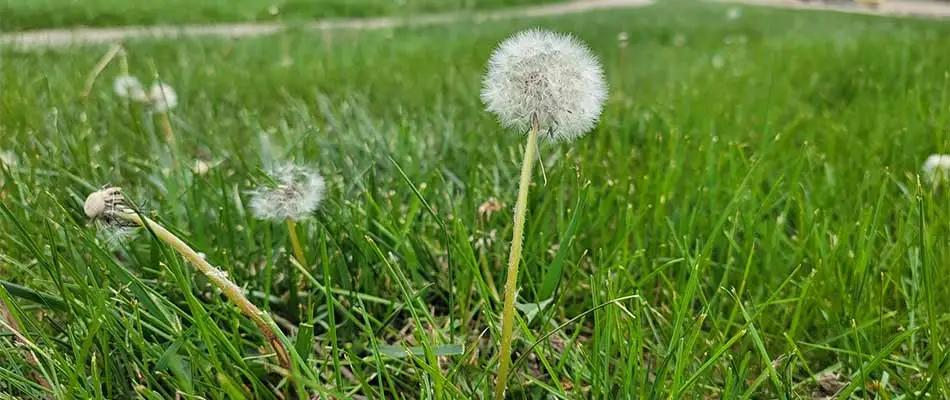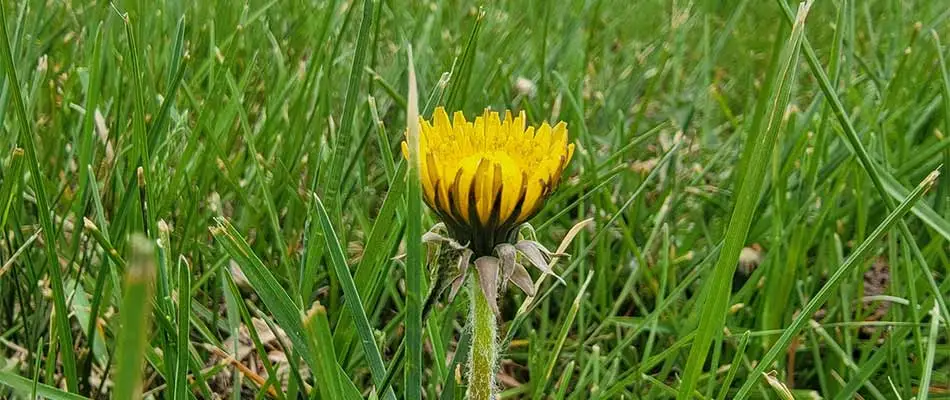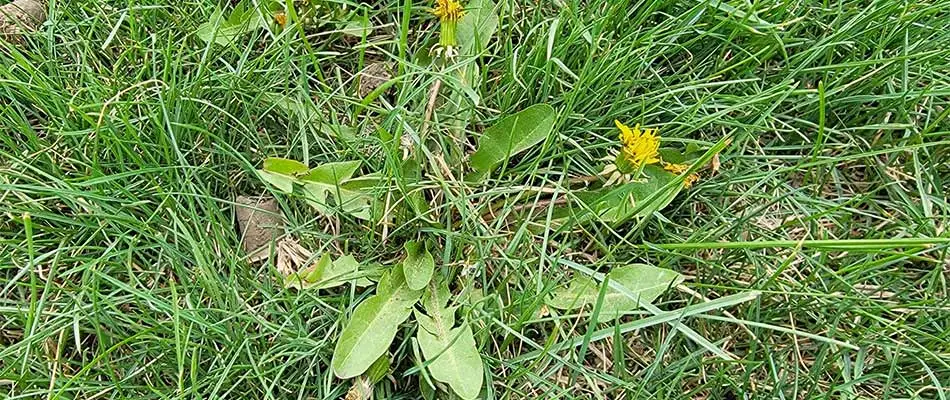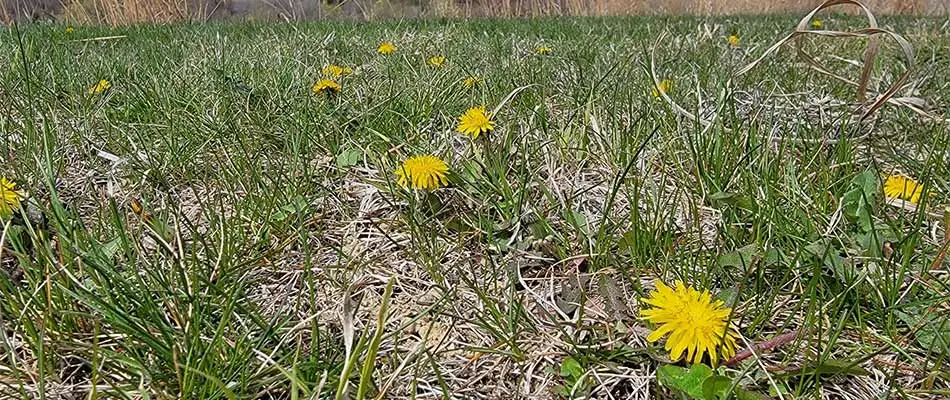To a child, dandelions are delightful symbols of spring and summer. Perhaps you still have memories of picking fresh, colorful bouquets for Mom or of blowing wispy seeds all-around a yard or meadow, chasing them on a breezy day. Maybe you made a wish before you scattered the fluffy seeds to the winds.
To a lawn-care expert, gardener, or homeowner, though, the sight of dandelions in the yard isn’t quite as thrilling. They’re far more likely to curse the appearance of those yellow flowers than they are to cheer them. That’s because, as pretty as they might seem to be, dandelions are really bad news for lawns.
Exactly why do people dread dandelions so much? When dandelions move in, they’ll push out grass and other plants. They’ll also consume water and nutrients that the plants nearby need. Finally, it can be tough to keep them from spreading. That delighted child blowing those seeds all over the lawn? Well, you see visions of future dandelions everywhere those seeds go. And what the kids don’t take care of themselves, the wind will.
So what are some ways to prevent and remove dandelions? That’s exactly what we’re going to explore in this article. But first, let’s learn a little more about dandelions and how they operate.
The Life Cycle of the Dandelion
From a purely scientific point of view, dandelions are pretty amazing plants. In addition to spreading so easily and efficiently, dandelions are also remarkably good at adapting to various climates. Dandelions, in fact, can be found in every state and territory in North America.
Considered a broadleaf weed, the dandelion has a fleshy taproot that grows deep into the soil and quite often branches out as well. Leaves that branch out from the taproot take on a rosette form and can remain green all year long, and the leaves, flower stalks, and taproot contain a milky juice that they secrete when cut. The telltale yellow flowers on leafless stalks make the dandelion very easy to recognize, as do the brown seeds with long white hairs attached to them. Those hairs are what make the seeds “float” so easily and far when the wind blows them, or a child scatters them.
Dandelions grow well in a variety of places. Some of their favorites are disturbed areas like vacant lots, cracks in sidewalks, roadsides, and along railroad tracks. Other favorites are open areas that get lots of sun. Such places include run-down meadows and, unfortunately, and of course, lawns and gardens.
Actually, although just about any lawn is going to see at least some dandelions, a lawn that isn’t very well tended is pretty much an ideal habitat for dandelions, and they can proliferate quickly in such a setting.
Controlling Dandelions
Strategies to control dandelions fall into two basic categories: removal and prevention. Removal options include digging them out by hand and using herbicides. Prevention can use herbicides, too, but the more effective strategy is maintaining a healthy lawn.
Digging to Remove
Digging by hand is a chemical-free way to remove dandelions. Although it can be very effective when done properly, it takes a lot of time and work, and proper removal isn’t always easy.
Pulling them up by hand or mowing them over seems like the simplest way to do it, but this is actually the worst way to deal with dandelions short of doing nothing at all. For starters, if they are in seed form, mowing and the yanking involved with pulling by hand will probably spread seeds. The bigger problem, though, is that deep taproot. It can grow 2-3 feet deep, making it extremely unlikely you will remove the entire root when pulling by hand. Therefore, the plant will just grow right back.
Since it’s essential to remove the whole plant, you have to dig the whole thing up, and that’s what takes a lot of time and work. It’s not so bad when there are just a few, but it’s a big deal otherwise.
The best time for digging dandelions up by hand is in the spring when the seedlings first appear, so learn to recognize the plant before it’s in its flowering or seeding stage. Check regularly for plants reemerging since you cannot always be sure you got the entire taproot. Your local gardening center may sell specialized tools that can make the digging and removal process easier.

Post-Emergent Herbicide Treatments
Post-emergent herbicides are weed killers applied after weeds appear, and you apply them directly to weeds where they emerge. This approach can be very effective, but it’s obviously going to be more expensive, and some people prefer not to handle chemicals (better to go with a local lawn-care service if you’re going to go this route). There’s also the risk of causing unintended damage to the lawn.
There are Two Types of Post-Emergent Herbicides You Can Use for the Job.
Option #1 is to use what’s called a selective broadleaf herbicide. The nice thing about this type of herbicide is that it only kills broadleaf weeds, so it’s good for lawns since you don’t have to worry about killing your grass as well, and it’s a good option for gardens as long as other broadleaf plants you want to keep aren’t close by.
The second option is to apply a non-selective herbicide. In this case, as the name implies, the herbicide is not selective about what it kills, meaning it will kill any plant that comes into contact with it. Experts typically recommend a non-selective herbicide as better suited for weeds that aren’t killed by selective herbicide. For example, if dandelions appear in walkways (think sidewalk cracks or stone walking paths), non-selectives are good because there aren’t other plants that they will kill. They also can be effective in flower beds when used carefully.
If in doubt about what type of post-emergent herbicide is best for the situation, take the time to consult a knowing person at a garden center or contact a lawn-care professional.
Pre-Emergents
A pre-emergent herbicide is a weed killer applied before weeds are present, with the goal being to prevent them from growing at all.
Typically, this approach isn’t as effective on dandelions as post-emergents are, but it can be useful if applied in late winter. If dandelion seeds in the lawn or flower beds haven’t yet germinated, it will keep them from doing so. If they have germinated, though, it doesn’t work.

Two Other Takeaways on Removal
- If you’re going to use herbicides, it’s important to use them before the flowers appear. Once flowers appear, dandelions have a lot more resistance to herbicides and therefore are tougher to kill. That toughness and ease of spreading make them formidable foes in lawn care, plain and simple flowers though they appear to be.
- Removal should always occur before the plant goes to seed. You can still kill and remove at that point, but there’s no way you’re going to keep some of the seeds from spreading, and you’ll be looking at dandelions again soon or next spring.
Proper Lawn Care and a Healthy Lawn

Killing and removing dandelions can be effective, but really the best way to manage them is to maintain conditions that make it harder for them to establish themselves in the first place.
The path to that involves a well-watered, well-fed, and properly mowed lawn. When you get those things right, you get grass that’s thick and strong. Dandelions, other weeds, and insect pests have a tougher time getting a foothold in such lawns. It’s lawns with thin or bare spots that weeds and other pests excel at invading and ruining.
Proper watering, mowing, and fertilizing all vary by region and climate, so be sure to talk to an expert about the right amounts.
Fertilization and Weed Control by Sharp Lawn Care

We pointed out something earlier, but which is important to make a reminder of: just about every lawn is going to get at least some dandelions. Even if you get your lawn completely dandelion-free, you’ll still get some later since the seeds can travel for miles through the air.
The key, then, is to stay on top of things with a good combination of offense and defense and make sure you never get behind. Catching back up gets progressively harder the more you fall behind, just like in a football game.
At Sharp Lawn Care, we’re trained experts and leaders in the field. With more than 16 years of experience serving the Sioux City and Sioux Falls regions, we know what we’re up against and how to manage it.
Our three core monthly service packages cover you for everything from the essentials to the premium treatment. All of them include varying amounts of fertilization, pre-emergent weed control, and targeted weed control. Your lawn is a big part of your most important investment, your home, and we know the value of keeping it healthy.
We also offer a full range of services from lawn enhancers to mosquito and pest control. To learn more or request a free quote, just call us today!




Comments (0)
Thanks for your comment!
Thanks for your feedback! Your comments have been successfully submitted! Please note, all comments require admin approval prior to display.
Error submitting comment!
There is a problem with your comment, please see below and try again.